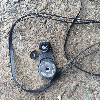That is a very common misconception. And as usual, Haynes is full of crap. . . .
The PCV system is designed to take FUMES from the crankcase that can (1) pollute the atmosphere and (2) harm your engine. It then re-introduces them to the combustion chamber to burn off. Remove your PCV and watch all kinds of problems pop up. . .
The tube you see on the valve cover (on a 5.0 for example) that goes from the oil fill spout to the air inlet ducting is NOT a breather. However, it can tend to work out that way. Remember...if your PCV is drawing air OUT of the crankcase...that air needs to be replaced or you have a vacuum in the crankcase. A crankcase under vacuum is a good thing...but not necessarily in this case. What we want is airflow through the crankcase. So air must come in the crankcase from somewhere...and that tube is it. If you will notice...that air is metered. In other words, it is taken AFTER the MAF sensor. That is because we want the ECM to know ALL the air that the engine is seeing. Remember...the PCV is taking that air and introducing it to the combustion process via the intake manifold.
Where things really get screwed up is when you (a) get a bunch of blow by from poor piston ring sealing, or (b) your pcv picks up a bunch of oil in suspension. The second is usually poor design by the OEM. In this case, a catch can is very beneficial. If you get one designed for the purpose, you will see it's more than just a place to hold oil. It actually has provisions to help drop the oil out of suspension. These cans are becoming more and more popular as horsepower levels increase...especially in supercharged cars such as the Cobra. If you are getting a lot of oil in the tube from the oil filler to the air intake, I would suspect another problem such as excessive blow by or a faulty or missing PCV system. That tube should have air pulling AWAY from the intake...not towards it. (in most situations)
In summary, if you feel you are having oil passed through your PCV system, install a well designed catch can in the line between the vacuum source and the PCV valve. Do NOT install a breather in the fresh air line between the inlet tube and the valve cover. You will introduce unmetered air to the combustion process.










